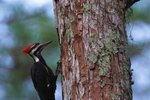Ohio is home to numerous species of mammal, including 10 different species of bat. Three other bat species have been recorded in the state but do not have known breeding populations locally. A number of the local bat species are classified as endangered. Their population reductions often result from interference in winter roosting areas.
Big Brown Bat
The big brown is the second most common bat species in the state. As the name suggests, it is a large species with thick brown fur on its back and a paler underbelly. It is a year-round resident of Ohio, dwelling in caves during the winter and more open roosts during the summer.
Big-Eared Bat
The big-eared bat is a rare species in the state, found only in Adams County. The species tends to migrate south during the winter and is mainly a summer resident of Ohio. The bat has distinctive long ears and two fleshy bumps on its snout.
Eastern Small-Footed
The eastern small-footed bat is the state's rarest bat species. It is a small species which, as its name suggests, has relatively small feet. Little is known of the bat's habits, but it seems to like mountainous habitats and winters in abandoned mine tunnels.
Northern Myotis Long-Eared Bat
The northern myotis long-eared bat is a medium-sized animal similar in appearance to its close relative, the little brown bat. It is distinguished by its longer, more pointed ears. It is a year-round resident of the state, wintering in caves and mines while using tree cavities for summer roosting.
Red Bat
Red bats have a reddish-brown fur. They also have long, pointed tails and wings with white shoulder markings. It is a solitary type of bat and does not roost in large numbers like most species. It is found roosting in tree branches in the summer and tree cavities in the cold months.
Eastern Pipistrelle Bat
The eastern pipistrelle is one of the state's smallest bats. It varies from yellowish-brown to reddish-brown in color. It has small, pointed ears and pinkish arms with black wing membranes. The bat spends the winter in caves and mine tunnels and uses tree cavities during the summer.
Evening Bat
The evening bat resembles a big brown bat but is just slightly smaller. It is an uncommon species in the state, living mainly in south central parts of Ohio. Winter roosts are not known in the state so it is likely the bats migrate south for the winter.
Indiana Bat
The Indiana bat is an endangered species at both state and federal level. It closely resembles the little brown bat, so much so it can be hard to tell them apart. During the summer months the males and females roost in different places, generally under loose tree bark or cavities. In the winter the bats move south to hibernate.
Silver-Haired Bat
The silver-haired bat, true to its name, has a frosted silver coloring to the tips of its fur, distinguishing it from other Ohio bats. It prefers to live in the mature northern forests of the state, making roosts in trees. During the winter it moves south to warmer areas.
Little-Brown Bat
The little brown bat is the state's most common bat species. It is sometimes mistaken for other local species. It has thick brown fur on its back with paler, almost gray fur on its belly. It is a year-round resident of Ohio, using caves and mine tunnels during the winter and tree cavities during the summer.
References
Photo Credits
-
David De Lossy/Photodisc/Getty Images





